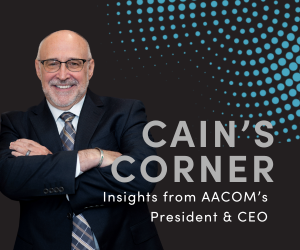NOM Week Statement from the CEO
Published April 21, 2022
By Robert A. Cain
Cains Corner
Keep Room for Growing Osteopathic Demand in Medical Residency
Have you celebrated National Talk in the Elevator Day, National Wiggle Your Toes Day, or National Eat a Pickle Day? If not, it’s not surprising because even though these are real, most people brush off these “celebrations” as passing humor. But there are important and critical groups honored by these national days and weeks; groups whose contributions and achievements should not be muted because of the overabundance of commemorations and silliness. Teachers, firefighters and yes, osteopathic physicians all fall into this latter category. What’s not silly is this week marks National Osteopathic Medicine Week, an opportunity to recognize the vital role osteopathic medicine plays in our national healthcare system as well as making sure that that role continues well into the future.
The fact is osteopathic medicine has been growing and resonating with more patients and pre-med students. In the last twenty years, 40 new colleges of osteopathic medicine (COMs) have opened and today, one quarter of all medical students in the United States are studying at a COM. Our graduates serve in communities of all sizes and in all specialties. They offer the same level of quality, the same commitment to science, and have the same duty of care, as their MD colleagues. Unfortunately, when first graduating from medical school, some still must overcome additional challenges when it comes to finding a residency opportunity.
This was the third year of the combined “Main Residency Match” administered by the National Resident Matching Program. While there are other “matches” that occur, the Main Residency Match is the largest match that touches most of our nation’s medical school graduates. Since moving to the combined match, graduates from COMs have performed very well. By the time most residencies started on or near July 1, 2020, more than 99 percent of doctor of osteopathic medicine (DO) graduates found a position. Last year, as anticipated, the numbers for the 2021 residency match were slightly down for both DO and MD graduates because a larger number of students were competing for residency positions. Nevertheless, the DO placement rate for residency remained high at 98 percent. However, we cannot get complacent and assume this will always be the case moving forward.
For while DO students match rates are trending up, they are not quite at the level of their MD peers. Why is this? There are legitimate concerns that some residency programs create an unequal playing field. One reason is simply reputation-bias. While historic and well-known institutions may be top of mind with residency program directors, there are thousands of incredibly talented and well-respected physicians practicing who graduated from lesser-known medical colleges, both osteopathic (DO) and allopathic (MD). We have seen Graduate Medical Education (GME) programs accepting only USMLE scores and forcing osteopathic students who took COMLEX (the licensing exam required of osteopathic medical students and accepted in all fifty states) to spend the time and money on a second licensing exam and even some GME programs demonstrating exclusion or bias in interviewing. In addition, there are examples of teaching institutions setting uneven student requirements for away or audition rotations, including higher fees. All of this has resulted in declines in matches by osteopathic graduates to certain programs and specialties.
Over the last two years, policies regarding student away rotations and program interviews were adjusted properly for safety concerns. Moving forward, keeping these limitations in place could disproportionately harm students who do not train in academic health centers (AHC) or attend larger “brand name” medical schools.
Colleges of Osteopathic Medicine (and some allopathic schools) utilize a distributed education model, where students do clinical work in community-based hospitals and health centers. Thus, DO students are interacting with patients and learning in the communities where (or similar to those where) they will eventually practice. A 2017 study in the Journal of the American Medical Association, found that less that 17 percent of patients received care in major academic health centers, or traditional “teaching” hospitals. Yet when it comes to some residency programs granting interviews, preference is often shown to students coming from an AHC.
To truly operate in a single system of graduate medical education, these kinds of built-in roadblocks and institutional bias must change. If we are to meet the physician workforce needs of this country, the entire medical community must work together to ensure there is a level playing field for all. The demand for DOs is increasing, so should opportunities for them to match with any program and in any specialty.

Robert A. Cain, DO
AACOM President and CEO

